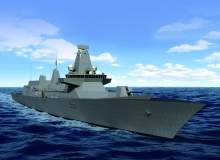
In 2021, the Royal Navy’s first Type 26 frigate, also known as a global combat ship (GCS), will enter service and, by the mid-2030s, these ultra-versatile vessels will have become the backbone of UK naval forces, entirely replacing the existing Type 23 frigates.
Entering service in the 1980s, Type 23 frigates were initially expected to have an 18-year life. But as they have spent most of their service in the Caribbean and Middle East, rather than the treacherous North Atlantic waters for which they were designed, their hulls have lasted almost twice as long as originally expected.
By the mid-2030s, however, these long-serving ships will have reached the point where they can no longer be upgraded, and a new class of frigate will be required to take over the Type 23’s duties.
Although frigates have never garnered the same amount of attention as big-ticket ships such as aircraft carriers, submarines and destroyers, they are the foundation of any modern navy. Versatile and affordable, frigates are multirole vessels that are capable of engaging threats on the water, underwater and in the air, protecting other navy ships, and undertaking independent action away from their task group.
Anti-submarine warfare (ASW) has always been near the top of the Type 23 frigate’s priority list, but these vessels have been involved in everything from anti-piracy missions to drug interdiction, and even humanitarian missions. The Type 26 must be similarly adaptable, changing roles and capabilities quickly depending upon the strategic circumstances.
The Type 26 lowdown
The Type 26, due to enter service from 2021 and remain active until the 2060s, has been in development since 1998, initially under the designation ‘future surface combatant’.
In March 2010, BAE Systems Surface Ships was awarded a four-year, £127m contract by the UK Ministry of Defence (MoD) to fully design the Type 26 GCS, which is currently underway.
Adaptability is paramount to the design of this future Royal Navy warship. Indeed, BAE describes the GCS as a "highly capable, affordable and adaptable multirole warship designed to support anti-submarine warfare, air defence and general purpose variants" and which is "capable of conducting global deployments".
The vessel is able to span a wide range of warfare operations from high-intensity conflict through to humanitarian assistance, and takes full advantage of modular design and open systems architecture to facilitate technology transfer and through-life support.
The importance of flexibility to the new frigate’s design is further emphasised by its plug-and-play design. While all variants will share a common acoustically quiet hull, the plug-and-play design – including combat systems, missile silos and a medium-calibre gun – allows the frigate to accommodate subsystems in order to meet the needs of individual countries.
Moreover, a key feature of the Type 26 frigate is its flexible mission space, which can accommodate up to four 12m sea boats; a range of manned and unmanned air, surface or underwater vehicles; or up to 11 20ft containers (‘capability modules’). BAE claims this delivers improved intelligence, surveillance, targeting and reconnaissance capability as well as ensuring that the vessel is future-proofed against further technological developments.
The programme to develop the Type 26 is being carried out by a team of around 250 engineers from BAE and the MoD, all of whom are evaluating capability, availability, exportability and support options for the ship, with the ultimate goal of developing a detailed specification for the vessel in readiness for manufacture.
As part of this process, the UK is committed to working with international partners through a series of bilateral relationships to learn more about their requirements and ensure they are met by the GCS. In September 2010, Brazil became the first such partner.
Advanced design software
Advanced marine design software is crucial during the design phase of any naval vessel, and in April 2012 BAE selected QinetiQ’s Paramarine software for the early-stage design and structural development of the Type 26.
Paramarine – a piece of easy-to-use, fully integrated naval architecture design and analysis software – is built on a modern platform and is perfect for the development of a versatile vessel such as the Type 26 because it can support the complexities of both ship and submarine. The Royal Navy has previously used Paramarine to design and analyse both submarines and warships, including the Type 45 destroyer HMS Daring and the nuclear-powered, 97m-long HMS Astute submarine.
The software features a comprehensive set of tools that addresses concept design, performance prediction, strength and structures, radar cross section, powering, manoeuvring, endurance, sea keeping, vulnerability and production design, and the 3D layout allows designers to rapidly define their concept design, and assess the weight and space balance of the finished vessel.
BAE Systems Maritime – Naval Ships hull and structure engineering manager Chris Muskett describes the software as "a powerful and effective ship design solution, which is very flexible, supported by a responsive and highly knowledgeable customer support team".
Modern missiles
Not only has the Type 26’s design software been selected, the MoD has also announced how the GCS will defend itself from aerial attack. A new missile system, known as Sea Ceptor and developed by defence firm MBDA, will replace the tried-and-tested Seawolf on both Type 23 and Type 26 frigates. Designed to deal with multiple incoming targets at the same time, Sea Ceptor launches from a vertical silo and accelerates towards threats at three times the speed of sound. The system uses a new UK-developed missile and can protect an area of around 500 square miles over land or sea.
Although Seawolf has undergone a recent revamp that effectively doubled
the missile’s range, the weapon is due to reach the end of its active life in 2016, making the MoD’s new contract with MBDA crucial to the capabilities of the future Royal Navy.
The Type 26 frigate is still years away from deployment, and much is sure to change between now and then. But the commitment of both BAE Systems and the MoD to producing the most versatile vessel possible to replace the long-serving Type 23 frigate is one thing that is certain not to waver. By the mid-2030s, there is little doubt that the Type 26 GCS will form the backbone of the future Royal Navy.
This article was first published in our sister publication Defence & Security Systems International.





